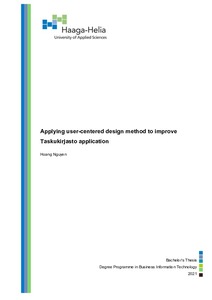Applying user-centered design method to improve Taskukirjasto application
Nguyen, Hoang (2021)
Nguyen, Hoang
2021
All rights reserved. This publication is copyrighted. You may download, display and print it for Your own personal use. Commercial use is prohibited.
Julkaisun pysyvä osoite on
https://urn.fi/URN:NBN:fi:amk-202104165001
https://urn.fi/URN:NBN:fi:amk-202104165001
Tiivistelmä
The rise of mobile devices and application-based solutions make services more accessible and approachable to the mass. To withstand the harsh competition against billions of easily available applications, a product needs to be able to adhere to its users’ real needs and be adaptive to their habits. Besides, users expect the design of the product to be approachable and coherent. Meeting these needs is ensured by applying user-centred design (UCD) methods during the design and development of the product. This thesis adopts the UCD approach to build a case study examining the user experience and usability of Taskukirjasto – a mobile application serving Helmet library customers. The application allows users to reserve, borrow and manage borrowed items among other activities.
The theoretical section introduces theories on (1) user experience, (2) UCD principles and methods, (3) usability and (4) conducting usability evaluation. The theories on user experience and usability explain the impact and features of a satisfactory design. The concept of UCD method then assists readers to understand an exemplary design process focusing on understanding users of a product. Last but not least, usability evaluation techniques discuss usability testing and heuristic evaluation as the chosen approaches to assess Taskukirjasto application.
The empirical section pursues usability testing and heuristic evaluation to conduct studies on Taskukirjasto, based on the fundamentals of usability methods. The usability test discovers usability issues reported by test users as they interact with the application. The heuristic evaluation assists a more thorough assessment of the application as it tackles use cases that are too contextual to be covered in the usability test.
The findings gathered from the study are interpreted and translated into design change recommendations. These resolve the most severe usability issues found through the usability evaluation. The proposed modifications aim to provide a more effective and efficient experience for users of Taskukirjasto. The changes are accompanied with reasons behind design decisions and its visualisation in the form of before-and-after comparisons.
The theoretical section introduces theories on (1) user experience, (2) UCD principles and methods, (3) usability and (4) conducting usability evaluation. The theories on user experience and usability explain the impact and features of a satisfactory design. The concept of UCD method then assists readers to understand an exemplary design process focusing on understanding users of a product. Last but not least, usability evaluation techniques discuss usability testing and heuristic evaluation as the chosen approaches to assess Taskukirjasto application.
The empirical section pursues usability testing and heuristic evaluation to conduct studies on Taskukirjasto, based on the fundamentals of usability methods. The usability test discovers usability issues reported by test users as they interact with the application. The heuristic evaluation assists a more thorough assessment of the application as it tackles use cases that are too contextual to be covered in the usability test.
The findings gathered from the study are interpreted and translated into design change recommendations. These resolve the most severe usability issues found through the usability evaluation. The proposed modifications aim to provide a more effective and efficient experience for users of Taskukirjasto. The changes are accompanied with reasons behind design decisions and its visualisation in the form of before-and-after comparisons.
